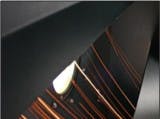Camfil Farr APC, Jonesboro, AR, has released a new spark arrestor option for its Gold Series cartridge dust and fume collection systems that channels sparks away from filters and into a dust collector's hopper to reduce risk of fire in laser cutting and other cutting/welding manufacturing applications.
The Camfil Farr APC device controls sparks without perforations or screens (unlike conventional perforated plate-type arrestors), using the sparks' kinetic energy to control their path and trajectory. The inlets on the device (with reversible transition) provide horizontal or vertical entry of the spark; their large length-to-width aspect ratio channels sparks into a narrow plane where they are easily maneuvered into the scalping channel. Sparks and embers are given more time to lose their energy while being directed to a safe area, with only very little loss of static pressure to the system. The device also is less likely to plug and accumulate material than perforated spark baffle systems.
The arrestor's modular construction accommodates varying air flow volumes; each module can handle a maximum of 10,000 cfm, with optimal volume of 7000 cfm at static pressure below 2" w.g. An access door enables removal of debris that may enter the dust collection system.
Applications include laser cutting, welding, and other spark-producing operations that do not involve combustible dust. (Combustible dusts require a spark trap and capture system isolated from the dust collector.)
(Source: Camfil Farr APC)

